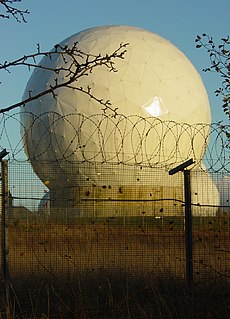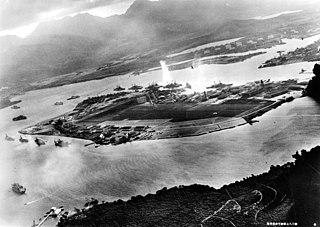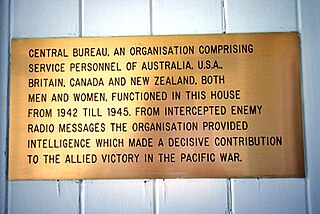
ECHELON, originally a secret government code name, is a surveillance program operated by the US with the aid of four other signatory nations to the UKUSA Security Agreement: Australia, Canada, New Zealand and the United Kingdom, also known as the Five Eyes.

The National Security Agency (NSA) is a national-level intelligence agency of the United States Department of Defense, under the authority of the Director of National Intelligence. The NSA is responsible for global monitoring, collection, and processing of information and data for foreign and domestic intelligence and counterintelligence purposes, specializing in a discipline known as signals intelligence (SIGINT). The NSA is also tasked with the protection of U.S. communications networks and information systems. The NSA relies on a variety of measures to accomplish its mission, the majority of which are clandestine.

The attack on Pearl Harbor was a surprise military strike by the Imperial Japanese Navy Air Service upon the United States against the naval base at Pearl Harbor in Honolulu, Hawaii on Sunday morning, December 7, 1941. The attack led to the United States' formal entry into World War II the next day. The Japanese military leadership referred to the attack as the Hawaii Operation and Operation AI, and as Operation Z during its planning.
MI8, or Military Intelligence, Section 8 was a British Military Intelligence group responsible for signals intelligence and was created in 1914. It originally consisted of four sections: MI8(a), which dealt with wireless policy; MI8(b), based at the General Post Office, dealt with commercial and trade cables; MI8(c) dealt with the distribution of intelligence derived from censorship; and MI8(d), which liaised with the cable companies. During World War I MI8 officers were posted to the cable terminals at Poldhu Point and Mullion in Cornwall and Clifden in County Galway, continued until 1917 when the work was taken over by the Admiralty. In WW2, MI8 was responsible for the extensive War Office Y Group and briefly, for the Radio Security Service.
Takeo Yoshikawa was a Japanese spy in Hawaii before the attack on Pearl Harbor on December 7, 1941.

The North African Campaign of the Second World War took place in North Africa from 10 June 1940 to 13 May 1943. It included campaigns fought in the Libyan and Egyptian deserts and in Morocco and Algeria, as well as Tunisia.
Magic was an Allied cryptanalysis project during World War II. It involved the United States Army's Signals Intelligence Service (SIS) and the United States Navy's Communication Special Unit.

Room 40, also known as 40 O.B. was the cryptanalysis section of the British Admiralty during the First World War.

The Pearl Harbor advance-knowledge conspiracy theory is the argument that U.S. Government officials had advance knowledge of Japan's December 7, 1941, attack on Pearl Harbor. Ever since the Japanese attack, there has been debate as to how and why the United States had been caught off guard, and how much and when American officials knew of Japanese plans for an attack. In September 1944, John T. Flynn, a co-founder of the non-interventionist America First Committee, launched a Pearl Harbor counter-narrative when he published a forty-six page booklet entitled The Truth about Pearl Harbor.
OP-20-G or "Office of Chief Of Naval Operations (OPNAV), 20th Division of the Office of Naval Communications, G Section / Communications Security", was the U.S. Navy's signals intelligence and cryptanalysis group during World War II. Its mission was to intercept, decrypt, and analyze naval communications from Japanese, German, and Italian navies. In addition OP-20-G also copied diplomatic messages of many foreign governments. The majority of the sections effort was directed towards Japan and included breaking the early Japanese "Blue" book fleet code. This was made possible by intercept and High Frequency Direction Finder (HFDF) sites in the Pacific, Atlantic, and continental U.S., as well as a Japanese telegraphic code school for radio operators in Washington, D.C.
The Signal Intelligence Service (SIS) was the United States Army codebreaking division through World War II. It was founded in 1930 to compile codes for the Army. It was renamed the Signal Security Agency in 1943, and in September 1945, became the Army Security Agency. For most of the war it was headquartered at Arlington Hall, on Arlington Boulevard in Arlington, Virginia, across the Potomac River from Washington (D.C.). During World War II, it became known as the Army Security Agency, and its resources were reassigned to the newly established National Security Agency (NSA).

Day of Deceit: The Truth About FDR and Pearl Harbor is a book by Robert Stinnett. It alleges that Franklin Roosevelt and his administration deliberately provoked and allowed the Japanese attack on Pearl Harbor to bring the United States into World War II. Stinnett argues that the attacking fleet was detected by radio and intelligence intercepts, but the information was deliberately withheld from Admiral Husband E. Kimmel, the commander of the Pacific Fleet at that time.
Radio Battalions are tactical signals intelligence units of the United States Marine Corps. There are currently three operational Radio Battalions in the Marine Corps organization: 1st, 2nd, and 3rd. In fleet operations, teams from Radio Battalions are most often attached to the command element of Marine Expeditionary Units.
Station HYPO, also known as Fleet Radio Unit Pacific was the United States Navy signals monitoring and cryptographic intelligence unit in Hawaii during World War II. It was one of two major Allied signals intelligence units, called Fleet Radio Units in the Pacific theaters, along with FRUMEL in Melbourne, Australia. The station took its initial name from the phonetic code at the time for "H" for Heʻeia, Hawaii radio tower. The precise importance and role of HYPO in penetrating the Japanese naval codes has been the subject of considerable controversy, reflecting internal tensions amongst US Navy cryptographic stations.

The Central Bureau was one of two Allied Signals intelligence (SIGINT) organisations in the South West Pacific area (SWPA) during World War II. Central Bureau was attached to the Headquarters of the Allied Commander of the South West Pacific area, Douglas MacArthur. Central Bureau's role was to research and decrypt intercepted Imperial Japanese Army traffic and work in close co-operation with other SIGINT centres in the USA, United Kingdom and India. Air activities included both army and navy air forces, as there was no independent Japanese Air Force.
A series of events led to the attack on Pearl Harbor. War between Japan and the United States had been a possibility that each nation's military forces planned for in the 1920s, though real tension did not begin until the 1931 invasion of Manchuria by Japan. Over the next decade, Japan expanded slowly into China, leading to the Second Sino-Japanese war in 1937. In 1940 Japan invaded French Indochina in an effort to embargo all imports into China, including war supplies purchased from the U.S. This move prompted the United States to embargo all oil exports, leading the Imperial Japanese Navy (IJN) to estimate it had less than two years of bunker oil remaining and to support the existing plans to seize oil resources in the Dutch East Indies. Planning had been underway for some time on an attack on the "Southern Resource Area" to add it to the Greater East Asia Co-Prosperity Sphere Japan envisioned in the Pacific.
SIGINT is a contraction of SIGnals INTelligence. Before the development of radar and other electronics techniques, signals intelligence and communications intelligence (COMINT) were essentially synonymous. Sir Francis Walsingham ran a postal interception bureau with some cryptanalytic capability during the reign of Elizabeth I, but the technology was only slightly less advanced than men with shotguns, during World War I, who jammed pigeon post communications and intercepted the messages carried.

The 24th Pursuit Group is an inactive United States Air Force unit. It was wiped out in the Battle of the Philippines (1941–42). The survivors fought as infantry during Battle of Bataan and after their surrender, were subjected to the Bataan Death March, although some did escape to Australia. The unit was never remanned or equipped. It was carried as an active unit until 2 April 1946.
Richard Motoso Sakakida was a United States Army intelligence agent stationed in the Philippines at the outbreak of World War II. He was captured and tortured for months after the fall of the country to Imperial Japan, but managed to convince the Japanese that he was a civilian and was released. Employed by the Japanese Fourteenth Army, he gathered and passed along valuable information to the Philippine resistance. He also planned and participated in the mass escape of about 500 Filipino prisoners.

The Intercept is an online news publication dedicated to what it describes as "adversarial journalism". It is supported financially by First Look Media, owned by Pierre Omidyar. Its editors are Betsy Reed, Glenn Greenwald, and Jeremy Scahill. Former editor Laura Poitras left the publication to work on non-fiction films. The Intercept also publishes two podcasts: Intercepted hosted by Scahill and Deconstructed hosted by Mehdi Hasan.











